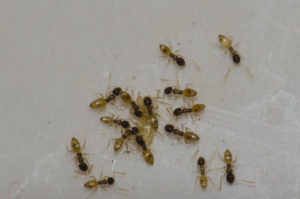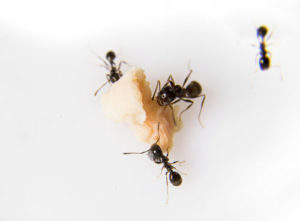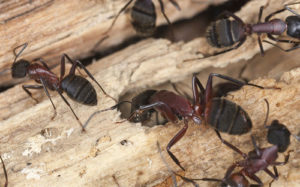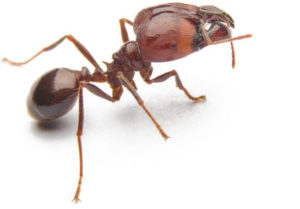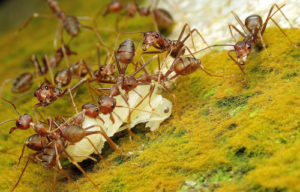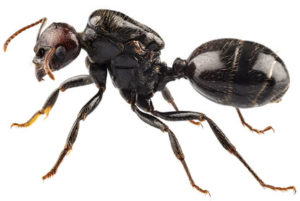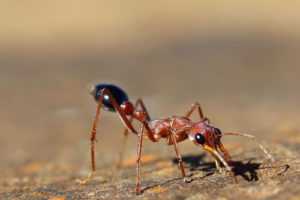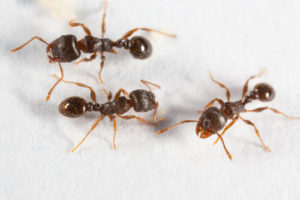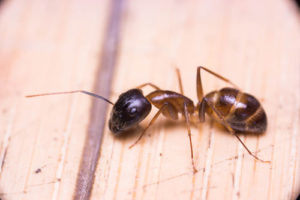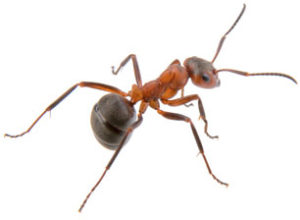Ants
ALL ABOUT ANTS
Ants have become the primary pest infesting homes in recent years and are usually very difficult to control. Successful control of ant infestations takes some skill that is gained through knowledge of ant behaviour and experience in dealing with ants.
ANT IDENTIFICATION
With more than 1,300 species in Australia, ant identification can be quite a challenge. Start by looking for trails. Ants very rarely travel alone and are usually spotted when they’re hunting as a colony along paths that have been well established. When you’ve found a trail, look at the sizes of the ants. Are they identical or do they vary in size? Also observe when the ants are active during the day or at night? Look for nests at the end of trails especially in areas with soil. Soil nests have distinct shapes or patterns depending on the ant species.
Ant infestations tend to happen fast. Regardless of whether your ant problem is an annoyance or an all-out infestation, you may be surprised to learn how fascinating these little creatures actually are.
ANT BEHAVIOR
Ants are social insects that live in colonies and have several different types or castes of individuals. Each caste has a different function or job in the colony.
- Workers forage for food, construct the nest and care for the young and the reproductives.
- Reproductives include the original queen and the swarmers. The original queen’s job is to lay eggs. Swarmers are winged males and females that fly out to start new colonies and spread to new areas. These swarmers mate during the swarm, and the male dies soon after. The queen then locates a suitable nesting site, sheds her wings and begins to set up a colony.
Ants develop by complete metamorphosis, meaning the eggs hatch into larvae that must be cared for by the workers. The larvae pupate into adult workers or reproductives. After two or three years, the colony matures and begins to produce swarmers every year.
ANT LIFE CYCLE
The lifespan of ants depends on the caste. Males live for only a few weeks and die after mating. Workers usually live for several months. Queens can live for decades under the right conditions. Ants are active all year long in tropical climates. In cooler climates, they survive the winter by going into a state of dormancy or inactivity known as diapause.
ANT CONTROL
To get rid of ants, it is important to identify the ant species before attempting ant control. Some ant species, like Pharaoh ants, can be controlled using baits, while others cannot. To get rid of ants successfully, it is usually necessary to follow them back to their colony and treat the colony directly.
Zeropest Australia technicians have the experience to correctly identify your ants and kill them with the appropriate treatment 100% PEST FREE GUARANTEED* & 100% SATISFACTION GUARANTEED*.
Common Ants You Will See generally inside your home.
ARGENTINE ANTS
(Linepithema humile)
Workers about 1.6mm long, light to dark brown in colour, do not swarm and there bite does not sting.
Worker ants produced in spring and increase in numbers up until autumn.
Winged ants (reproductive Kings and Queens), produced in early spring, before the workers, mature within three months and mate soon afterwards.
Argentine ants mate in their nest so no swarming is seen.
Worker ants will follow food trails for long distances so nests are not easy to track.
They prefer sweet foods but will also eat live and dead insects, meats, cereals and damaged fruit.
Argentine ants drive out other ant species from an area.
Black House Ant
(Ochetellus)
Black house ants are shiny and black, 2.5 - 3mm long.
Larva hatches out of the egg as a white grub which is narrower towards the head. They are fed by the adults.
The adult emerges with the three defined body sections: head, thorax and abdomen.
The length of time between the egg stage and ants emerging as adults can take 6 weeks or more; it depends on a variety of factors such as the species of ant, the temperature and the availability of food.
Fertilised eggs become female, unfertilised become males.
Habits
These ants are regarded as a nuisance and scavenge in kitchens, garbage and also dog excrement, therefore potentially spreading diseases such as salmonella.
Common Ants' include the intensely black 'Black House Ants', and they are attracted to sweets.
The most effective control measure is to find the colony and treat it.
Carpenter Ant
(Camponotus)
Carpenter ants are polymorphic which means they can come in a variety of sizes.
There are three size classes, each with different job classifications: Major workers are the largest ants in a colony and contain most of the large soldier ants; while media and minor carpenter ants are mid and small in size respectively and whose jobs are to gather food and construct colonies.
Carpenter ants are nocturnal, you will often have to wait for night time to find a trail, which could lead to the nest.
Carpenter ants do not tend to travel in large numbers, so a trail may be difficult to spot.
Carpenter ants usually do not just set up one nest, but a whole series of ‘satellite’ nests too, which ensures the colony’s survival even if one nest is destroyed.
Carpenter ants feed on living and dead insects as well as anything people consume.
As the name suggests, carpenter ants can do considerable damage to wooden objects.
Fire Ant
(Solenopsis spp)
Appearance
Queens are 1.59cm long and workers are 3.18mm - 6.35mm long, coppery – brown on the head and body, with a darker abdomen.
Solenopsis has a very distinctive two–segment antennal club, which is most visible in the front view of the female reproductive ant.
After swarming from the nest and mating, the queen searches for a suitable spot to lay her eggs. Once found, she can lay up to 125 eggs in late Spring.
Larvae hatch within 8 to 10 days, and the pupa stage lasts for 9 to 16 days.
Larvae feed on secretions from the queen’s salivary glands and broken down wing muscles until the first worker ants emerge. After this first batch of larvae moult into workers the queen’s role returns to egg laying – she can lay up to 1500 per day. Worker ants continue with larval care, nest building and food foraging.
Fertile males are produced later in the season.
Foraging workers diet consists of dead animals, including insects, earthworms, and vertebrates. Workers also collect honeydew and forage for sweet food, proteins, and fats.
Warming characteristics – mating between queens and fertile males takes place on the wing mid to late summer. Males perish after mating.
Nest locations can be a mound of up to 40 cm or next to objects found on the ground, e.g. logs.
If aggravated, these react aggressively and can inflict a painful sting, resulting in a pustule some 48 hours later.
These ants are a major agricultural and urban pest, destroying crops and invading residential areas both outdoors and indoors.
Pharaoh’s Ant
(Monomorium pharaonis)
Appearance
Workers 1.5-2mm long, yellow-brown with brown abdomen.
Males are 3mm long, black, winged, Queens are 3.5-6mm long, dark red in colour with wings.
They Have black eyes and 2 small segments at the pedicel.
Multi-queen colonies, swarming can take place at any time of the year.
Winged adults seldom fly so rarely seen. Wings are soon lost after mating.
Well–defined trails are laid which are often associated with heating systems. Feeds indoors on high protein foods — meat, fats, blood, dead insects, etc.
Swarming characteristics — new colonies are often formed through nests that have been disturbed e.g., as a result of insecticide spray treatments.
Each queen produces up to 3,500 eggs in its lifetime.
Nest locations — deep seated in cavities in heated buildings. Often found in hospitals. Associated with humid conditions. Colonies can range from a few dozen to 300,000 individuals.
Ghost Ant
(Tapinoma melanocephalum)
Ghost ants are pale/translucent legs and abdomen, 1.6mm long, continuous breeding colonies.
Feeding – indoors: sweet substances and grease; outdoors: insects that produce honeydew.
Nesting – indoors: small spaces, wall voids; outdoors: in flowerpots, under objects on the ground, under loose bark.
Locations - attracted to high moisture areas, can be found in kitchen and bathroom cabinets.
Colonies can occupy several different nesting sites.
Ants that you generally see outside.
Garden Ant
(Lasius niger)
Appearance
Workers are 4-5mm long, Queens are 15mm long, dark brown - black in colour.
Small segment at waist point (pedicel) with no sting present.
Bull Ant
(Mymecia)
Appearance - About 18 - 20mm long and tends to be red or black.
Very aggressive (if a nest is disturbed, there will be a massive outpouring attack).
They can inflict a very painful sting to humans.
The stinger does not remain in the victim, so the Bull Ant can sting repeatedly.
Pavement Ant
(Tetramorium caespitum)
Appearance
Dark brown or blackish, 3mm long, 6 legs, spines on the back and 2 nodes on petiole.
Grooves on head and thorax, thorax uneven with 1 pair of spines.
12-segmented antennae with 3-segmented club, winged ants are often mistaken for termites.
Sugar Ant
(Camponotus app)
Appearance - This species vary greatly in shape, size and colour.
They range from 2.5 to 15 mm, and are some of the most often seen ants due to their size and often bright in colouring. They are unable to sting, but they do possess strong mandibles which can bite.
Coastal Brown Ant
(Pheidole megacephala)
Appearance - About 1.5 - 2.5mm long and tend to be yellow brown to brown.
Green Ant
(Rhytidoponera spp)
Appearance – About 5 - 6mm long, black with metallic green head with a distinctive appearance and odour. They can inflict a painful sting to humans.


